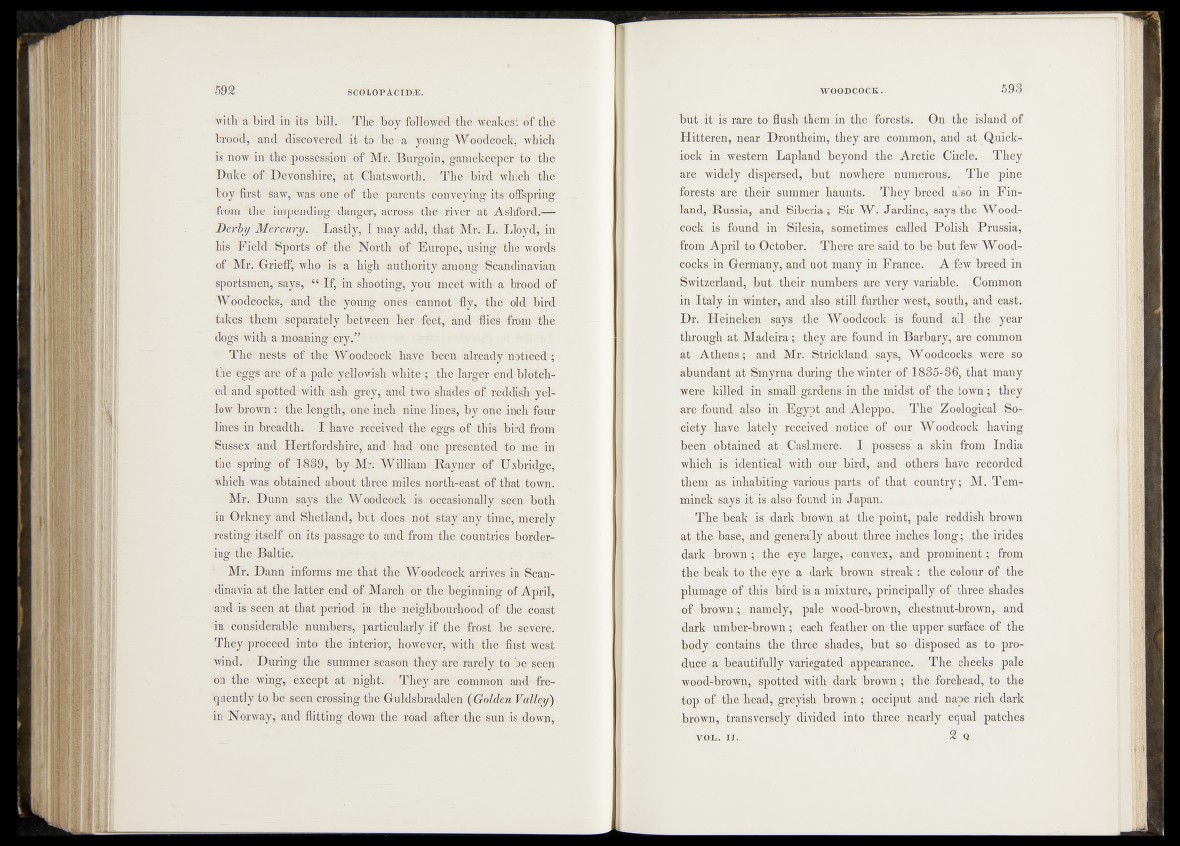
with a bird in its bill. The boy followetbthe-weakest of thé
brood, and- discovered' it !to vbe-f a young Woodcock/ Whk$h_
is now in ^heyboèsessr©iï>of MrTBurgöih /gémelfeeper to *thi\
Duke “óf Devonshire, %f'"GhatSworthl Thè^bird whiclf/tih©
first law, was-one-of the^^iFiSrits^eantvfeyin^-its offspring
from ^hEjjmpending danger^ a^SeSs* ^he river at A#h&rds^
Derby mhyadd, that Mr^f^Lfeyd, iii
’his Field-Sports of the? North of EurOpe/h^ing* the words
of -Mr. Grieff, who a high* autho-rity^among' Scandinavian
sportÉnen/says/ w If, in shoót^g,»yèn 'in.êert‘ witeSta' brood'óf
Woodcocks, and the young dries- cannot •fly, st!h#'cS®i“bird
takes them- separately between-' hermeet,^U<h*fl»iéS »from ',ihè
dogs with a mo a n i n g - ; f
'*t The’1 nests of the W Oödcockhayé’ l^eeK-4already notil'êÉ^
the^ggsure of a- pale/yellowish-fahité / /h e largdr end'blotched;
and spotted* With ash grey,__and two" shades of rkdrd&sh§yel!-
low brown: the lengthy one inch nine lihkspfcy-^e irfcfefibur
iaes< in breadths Thave uedeived/hé'eggs-of this bird fr®m
hhissex'and Hertfordshire, and had ?oié presented to metin'
the spring of 1819,■ by Mr; William Rayner oisUxbridg'd,
which was obtained about three miles north-east bf that; tow®.,
Mr. Dunn "says- the-Woodcock is^oeeasronallyfseeh? both
in Orkn^É^d Shetland/but dóes n'Ot'tStt^pny t-ime,- merely
réstingntself bh its passage tó andrfrom the. countries bordering
the Baltic. ï
Mr. Danri inform sme that the Woodcock arrives in Scandinavia
at the latter end of March or the beginning of April;
and is seen at that period in tho^neighbotrhood of the boast
in considerable numbers, particularly if the frost be severe.
They proceed ini# |he interior/however, with thé first west
wind. During the summer season they arhrarely to berseen
on the wing, except at night.:/They are. 'eommoirnnd frequently
to be seen crossing the Guldsbradalen {Golden Valley)
in Norway, and flitting down the road fafter the sun is down,
but it is rare to flush them in the forests. On the island of
Hitteren, near Drontheim, they are common, and at Quick-
ipck' in western Lapland beyond the Arctic Circle. They
are widely.Vdispereed, but .nowhere numerous. The pine
forests are their summer haunts. They breed also in Finland,
Russia, a n ^ Siberia-,y Sir W . Jardine, says the Wood»
cock is found in Silesia, sometimes called Polish Prussia,
from A p r i l s October, l There; are saidito be but few Woodcocks
in Germany, and not .many in France. A few breed in
Switzerland* but their numbers are very variable. Common
in I taly in winter, and also still further west, south, and east*
Dr. Hemeken/ says, -,%e« Woodcock- is- found all the year
through at Madeira; they are found in Barbary, are common
at Athens; and Mr. Strickland, says, Woodcocks were so
abundant at Smyrna during -the winter of 1835-.36, that many
were killed in small gardens, in the midst of the town; they
are fouHd ^tso,dn' Egypt and Aleppo. The .Zoological' So»
ciety have, lately received notice^pf, our Woodcock having
been obtained at, Cashmere. I possess’ a skin from India
which -is identical with .our. bird^ and others have recorded
them as inhabiting various parts of that country; M. Tern-
minck says if sis also found in Japan.
The beak is dark brown at the point, pale reddish brown
at the base, and generally about three inches long; the irides
dark brown ; the eye large,- convex, and prominent; from
the beak to the eye a dark, brown streak : the colour of the
plumage of this bird is a mixture, principally of three shades
of brown; namely, pale wood-brown, chestnut-brown, and
dark umber-brown; each feather on the upper surface of the
body contains the three shades, but so disposed as to pro-
duce-a beautifully variegated appearance.: The cheeks pale
wood-brown, spotted with dark brown ; the forehead, to the
top of the head, greyish brown ; occiput and nape rich dark
brown, transversely divided into three nearly equal patches
VOL. I I . 2 Q